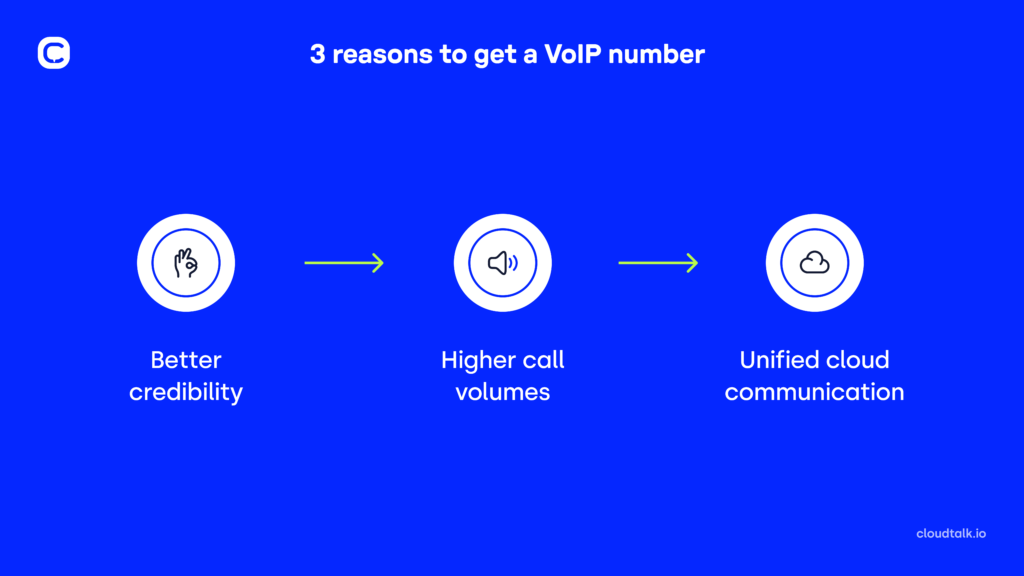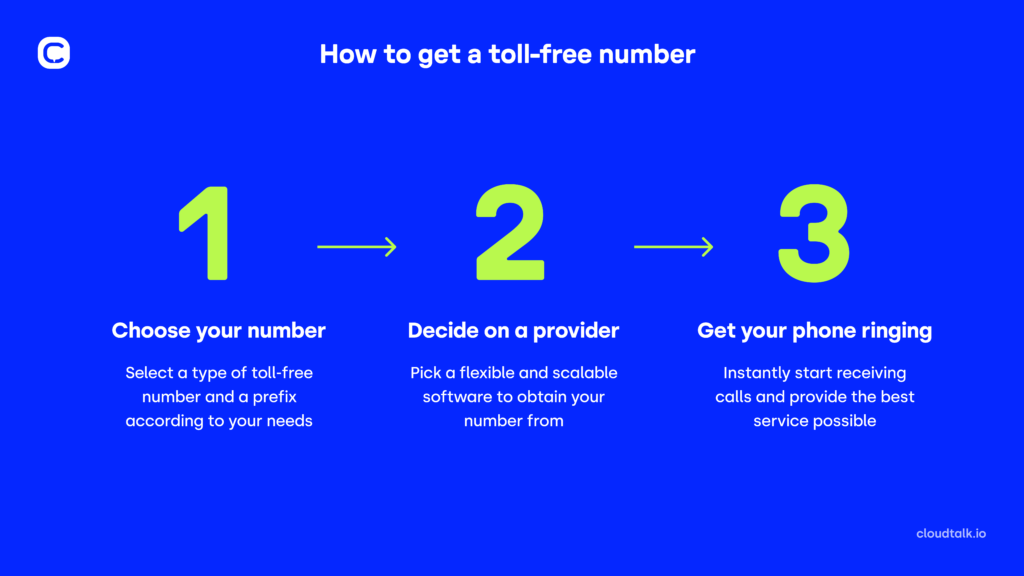What is a Toll-Free Number, How Does It Work, and How to Get It?
You certainly heard about toll-free numbers. But what you may not know is that these 3-digit phone numbers are a golden mine of business communication. They generate an estimated $200 billion in annual sales in the US alone. Businesses using toll-free numbers also noticed a 30% growth in purchases.
That’s because the ability to call businesses easily and for free fosters better connections with customers, therefore boosting their satisfaction and loyalty. So, it’s no mystery that there are more than 8,000 toll-free numbers registered every day.
In this blog, we’ll explore what toll-free numbers are, how they work, how much they cost, how to obtain them, and how exactly your business can benefit from them.
Let’s dive into it.
Key takeaways:
- Toll-free numbers provide a free communication channel for customers, with the cost borne by the number’s owner. They are typically recognized by their unique prefixes.
- Toll-free numbers offer flexible call routing options and are compatible with VoIP services, allowing for streamlined communication.
- Toll-free numbers boost business credibility, increase call volumes, and allow for cloud-based communication solutions that save on hardware and maintenance costs.
- Acquiring a toll-free number involves choosing a suitable type and prefix, selecting a provider, and setting it up.
- VoIP providers like CloudTalk offer seamless implementation, allowing businesses to leverage toll-free numbers alongside advanced communication features.
What is a Toll-Free Number?
First, you should understand the meaning behind a toll-free number. It’s a type of phone number customers can dial without being charged for the call. Instead, the cost is paid by the number’s owner. Therefore, a call receiver.
You can recognize a toll-free number by its unconventional format. It starts with specific prefixes, the most common being 800.
The main point of toll-free numbers is to make your business contact memorable. They also create a bridge between you and your customers. By giving them an option to call you without worrying about expensive long-distance charges, you evoke a feeling of safety.
Because of that, toll-free numbers are typically used by sales, customer support, and other customer-facing departments.
Fun fact: Toll-free numbers are so attractive that when prefix 800 was introduced in 1967, the authorities had to come up with 8 million variants.
How Do Toll-Free Numbers Work?
When a customer dials a toll-free number, the call is routed via a network of telecom providers to the recipient. The recipient is then charged based on different attributes (more about those later), while the customer pays nothing, no matter from where or which device the call comes from.
You can call toll-free numbers exactly the same way as any other number. Although, there is one thing to keep in mind. In order to call a toll-free number, you have to dial “1” before the actual toll-free prefix.
It should look like this:
- 1 (800) 123 456…
- 1 (855) 123 456…
- 1 (877) 123 456…
A common mistake is that people think toll-free prefixes are interchangeable. Yet, it’s important to understand that even if you are calling the same number, a different prefix will connect you to a different recipient.
Imagine these prefixes as area codes for a country where you want to call. To contact the “area,” you have to choose a code that corresponds with the given location.
Toll-free vs. Local Numbers
Before we dive into the comparison, let’s briefly define what local numbers are. As we actually hinted in the example above, these numbers have a specific area code, depending on the region where you want to call.
For example:
- Madrid: +34 (91) 123-4567
- Berlin: +49 (30) 123-4567
- Paris: +33 (1) 123-4567
- New York City (all): +1 (917) 123-4567
What’s the Difference Between Local and Toll-Free Numbers?
We already mentioned that local numbers are tied to a specific location. This is the first major difference since toll-free numbers aren’t geographically location-sensitive. Just by a toll-free number prefix, the caller cannot know which city or country they are calling.
Now, let’s take a look at the other key differences:
Aspect
Toll-Free Numbers
Local Numbers
Cost
Calls are free for the caller, charges are covered by the business
The caller bears the cost of the call
Accessibility
Nation-wide outreach
Limited to specific geographic area
Perception by caller
An image of an established global business
An image of a small, local business
Call Volume Management
Suitable for high call volumes
May be sufficient for low to moderate call traffic
Marketing Appeal
Widely recognized and trusted
May lack the universal appeal of toll-free numbers
Should You Get a Local or Toll-Free Number?
It highly depends on your needs, but you can start by asking yourself these 2 questions:
- Question: “Do I have a local customer base, or is my business spread internationally?”
Answer: If your business operates locally, local numbers will be sufficient. They will evoke an image of a small, local service and build trust in the local community. On the contrary, international businesses benefit more from toll-free numbers, thanks to their association with established companies and generic, non-country-sensitive character.
- Question: “Am I planning to expand my business abroad in the near future?”
Answer: This one is pretty straightforward → If your plan is to grow globally, it’s worth purchasing a toll-free number immediately instead of having to change it later.
Here’s an example: if you are a local agency that wishes to keep operating in a single country, opt for a local number. If you are a quickly growing or already globally established software provider, you’ll benefit better from toll-free numbers.
Types of Toll-free Numbers
Even though toll-free numbers only have 3 digits, there are many types of them, each serving its unique purpose.
Here’s a breakdown:
#1 Standard Toll-Free Numbers
“Standard” toll-free numbers are the best-known ones, always starting with 8. Callers can dial them anywhere in the world.
Let’s take a closer look at them:
Standard Toll-Free Number 800
What are 800 numbers? This prefix is the oldest and most commonly recognized. We already mentioned that when AT&T first introduced it, it caused a massive market boom. This famous, easy-to-remember business phone number is strongly associated with credibility and establishment. But, as everything, it has its downfall—due to its popularity, it’s very difficult to obtain it.
And you’ll about to understand why there’s such a fuss around it:
It’s proven that the number 800 has by far the best conversion rate → nearly 60% higher than that of the youngest 866.
Other Standard Toll-Free Numbers can be:
- 833
- 844
- 855
- 866
- 877
- 888
#2 Local Toll-Free Numbers
Even though toll-free numbers generally aren’t tied to geographical regions, there is one type only tied to a specific area—local toll-free numbers. Your customers can only call them free of charge domestically. For international calls, they are charged just as they would be when calling a regular phone number.
#3 International Toll-Free Numbers
As we said, with toll-free numbers, you can make inbound calls from any country in the world free of charge. Yet, when calling abroad, you have to add a corresponding country code before the toll-free prefix and create an international toll-free number.
For example:
- UK: +44 (888) 123 456
- US: +1 (888) 123 456
- Spain: +34 (888) 123 456
- Germany: +49 (888) 123 456
#4 Virtual Toll-Free Number
This type is associated solely with cloud-based VoIP phone systems, where toll-free numbers are part of monthly subscriptions. The VoIP provider functions as a distributor of toll-free numbers.
Besides making and receiving calls, choosing to get your toll-free number within a VoIP plan brings many additional features. These include skill-based or caller-based routing, voicemail, analytics for measuring performance, and AI-powered features to fully automate your processes.
But we will tell you more about this later.
What Are the Benefits of Toll-Free Numbers?
Toll-free numbers reached a tremendous success and they can bring the same to you. Actually, getting a toll-free business phone number has almost no drawbacks.
Let’s deep-dive into how you can benefit from them:
#1 Boost Your Credibility
Toll-free numbers evoke an image of a professional, established business. Why is that? For one, well-trusted large companies are famous for them – 99% of them use a toll-free number, and that’s only in the US. Secondly, having one in place indicates an international presence.
That logically works in favor of small companies and SMBs that aspire for global success. Toll-free numbers help to eliminate the stamp of these businesses being less legitimate than their larger competitors.
#2 Increase Call Volumes
Knowing that they won’t break the bank when calling a toll-free number motivates more customers to contact you – even if their issue isn’t very urgent.
That gives you two advantages:
First, customers who are on the fence about your product will be more inclined to contact you and resolve their issues instead. Second, and this goes hand in hand with the first advantage, you’ll build an image of a carrying company, boosting their loyalty, improving satisfaction, and lowering churn.
Although, it’s worth acknowledging that higher call volumes may stress your agents.
Download our eBook on how to boost productivity in your call center to get valuable tips:
Discover 10 surprisingly easy ways to boost your productivity.
#3 Change Landlines For Cloud
Even though it may not directly relate to the benefit of using a toll-free number, it is connected to the possibility of acquiring one. Toll-free numbers give you the freedom to choose on what platform you want to use them. And here we come back to the VoIP cloud telephony providers.
We promised that we would elaborate more on this topic, so here we go:
When choosing to obtain toll-free numbers at a VoIP provider, you can also eliminate landlines and unify your entire communication in a shared online space.
VoIP software also integrates with your bellowed tool and makes it very easy to scale. You can add or remove toll-free numbers based on call volumes or number of agents, what’s perfect if your company size fluctuates.
In CloudTalk, we offer toll-free numbers as an essential feature in every subscription plan, starting at 25 per user/month.
Contact our sales team to find out more.

How Much Do Toll-Free Numbers Cost?
The cost of acquiring a toll-free number depends on many factors, so determining an exact price isn’t really possible.
Yet, there are 3 main factors that affect the price:
#1 The Provider You Choose:
Where you acquire your toll-free numbers is perhaps the most important factor influencing the final cost. The wisest option is to get the number via a VoIP provider. Not only will you get all the advanced features we mentioned earlier, you will save a significant amount of money on implementation and maintenance.
VoIP solutions require little hardware besides an internet-enabled device (mobile phone, computer, or tablet) and a headset. This fact already saves you hundreds, sometimes thousands, of dollars. According to business.com, the on-premises hardware price for a 20-user team can grow to as much as $7,500.
Furthermore, there’s no need for an IT professional to set up your infrastructure since you can implement the software yourself in a matter of minutes. Maintenance also isn’t at your expense since it’s done by your VoIP provider.
Basically, you’ll only have to pay a monthly subscription fee, which typically ranges between $10 and $100 per user/month, and for the toll-free number itself, which may cost you between $5 and $30 on average.
#2 Charges for Inbound and Outbound Calls
As you know by now, toll-free numbers require the owner, therefore you, to cover all phone service charges for each call. Make sure to carefully check the terms that your provider has in place regarding toll-free calling fees.
Some providers charge for every call made and received on your number. These are so-called call origination fees (for inbound calls) and call termination fees (for outbound calls).
Generally, there are 3 toll-free number pricing options:
- Per-minute pricing: you pay a small fee for every minute spent on the line.
- Plan rates: You’ll get a certain amount of minutes from your provider depending on which subscription plan you’ll purchase.
- Bundled minutes: You pay a fixed amount of money for a fixed number of minutes, such as 300 minutes per user/month.
#3 Caller’s Location
The price of toll-free calls also depends on where the caller is located. If you are in the US and someone is calling you from Canada, it will be cheaper than if someone is calling you from Australia.
Let’s say the calling fee for the neighboring country is $0.02 per minute. The fee from the other side of the world may grow to $0.10 per minute. However, this is often a case of landline phone systems since many VoIP providers have this fee already incorporated into their monthly subscriptions.
How To Get a Toll-Free Number?
Now that you learned everything there is to know about toll-free numbers, it’s time to acquire one. Doing so is surprisingly easy.
You can do so in 3 simple steps:
#1 Decide on Your Toll-Free Number
Before you do anything else, decide on the type of toll-free number and prefix you want. It may be standard, local, international, or any other type.
Since there’s a high demand for toll-free numbers, you’ll also need to know whether the one you chose is available. However, your provider does this, so there’s no research needed on your side.
To boost the chance for your toll-free number to be available, don’t limit yourself to the most requested 800 prefix. For example, you can consider the newest format, 866.
#2 Choose a Provider
In order to get the toll-free number you desire, you may contact a RespOrg (Responsible Organization), which is a company authorized to index these numbers and subscribe them to your business. These are usually mobile and landline service providers.
But as you know by now, the VoIP providers that offer toll-free VoIP numbers also function as RespOrgs. All you need to do is choose one, contact their sales team, select a plan that suits your needs, tell them what toll-free number you want, and let them implement it for you.
#3 Start Using Your Toll-Free Number
Once your toll-free number setup is complete, you can start calling from it straight away. If your toll-free number is text-enabled, you can also send and receive SMS with it.
Don’t forget to take full advantage of additional VoIP features. For example, set your IVR call routing to personalize the callers’ journey and boost their experience.
The last thing you shouldn’t forget to do is promote your new toll-free number on all channels to make sure customers know how easily they can reach you.
After all, a study proved that customers are more likely to purchase if they can easily find a toll-free number on your website!

Get Your Toll-Free Number Today
Toll-free numbers offer businesses an excellent way to establish a direct and professional communication channel with customers, allowing them to reach you without incurring call costs.
This not only builds trust and credibility but also opens up new avenues for customer engagement and satisfaction. From seamless routing to efficient call management, toll-free numbers are versatile tools that help businesses streamline their communication processes.
To explore the potential of toll-free numbers and enjoy their benefits, consider choosing a VoIP solution like CloudTalk. Our software also provides a suite of additional features, integrations, and AI capabilities that can help elevate your business communication.
So, don’t miss out on the opportunity to enhance your customer service and business outreach. The next time a customer needs the services you offer, they’ll call the number they know.
Yours!
Ready for a toll-free number?
FAQs
What countries support toll-free numbers?
Toll-free numbers are available in many countries around the world. The most common prefixes, like 800, are recognized in countries such as the United States, the United Kingdom, and Israel, among others. Additionally, different countries have their own specific toll-free prefixes, such as 0800 or 0808 in the UK and 1809 in Israel.
How many toll-free numbers can my business have?
There is no set limit to the number of toll-free phone numbers a business can have. It fully depends on the needs of the business and the availability of numbers from the provider. Many VoIP services, including CloudTalk, allow businesses to add or remove toll-free numbers as required.
What is the difference between a toll-free number and a regular number?
A toll-free number is one where the caller can reach the business without incurring any charges; the cost is covered by the business receiving the call. In contrast, with regular numbers, the caller typically bears the cost, particularly for long-distance or international calls. Toll-free numbers also have specific prefixes, like 800, that distinguish them from regular numbers.
How are toll-free numbers relevant for businesses of different sizes?
Toll-free numbers are relevant for businesses of all sizes. For small businesses, they offer an opportunity to build credibility and appear more established by providing a nationwide or global communication channel. For larger companies, toll-free numbers help manage higher call volumes and ensure efficient call routing to different departments, enhancing customer service.
Can I change my toll-free number?
Yes, you can change your toll-free number. Many providers, including CloudTalk, offer services to help businesses port their existing numbers or switch to new toll-free numbers, streamlining the process. To learn more about number porting options, visit CloudTalk’s Number Porting page.

























